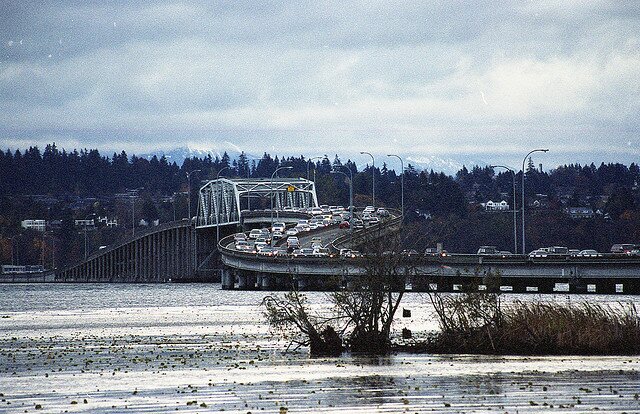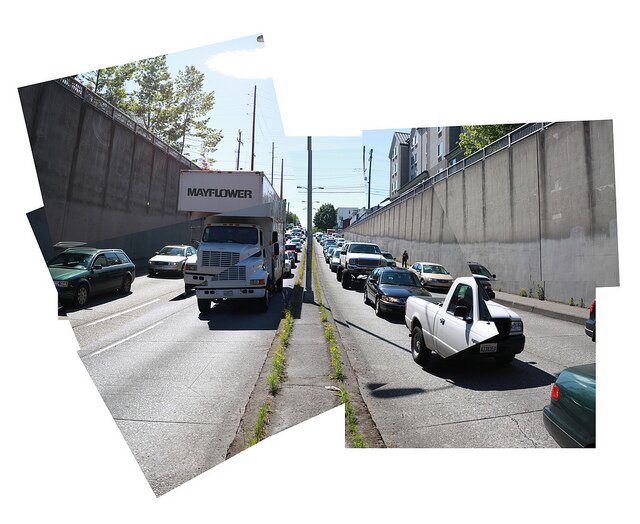
You know what’s being compared to Y2K? Los Angeles’s Carmageddon-that-wasn’t. Big hype, not much to worry about. The Los Angeles Times writes:
Life without the 405 Freeway to connect the San Fernando Valley and Westside was remarkable only for what didn’t happen. The canyons of the Hollywood Hills did not become giant parking lots. Hospitals did not go unstaffed. Stranded motorists did not abandon their cars and stagger down the freeways in search of food and water.
The sound of silence wasn’t just on 405. It was everywhere, the paper reports. Enough people stayed home that fans who turned out for the L.A. Galaxy v. Real Madrid soccer match got there “with time to kill.” Cyclists raced–and beat–JetBlue flights from Burbank to Long Beach in #FlightVsBike. “In fact,” recounts Seattle Bike Blog, “the people riding bikes arrived in half the time it took to go through security, fly, then take a cab.”
Seattle, of course, had its own version of Carmageddon in 2007. 19 days of a partially closed I-5, not just a weekend. But at the end, out came the Y2K comparison: “Traffic got a little worse later in the first week — but remained far better than average, despite slowdowns through the construction zone. […] Now that we know how the story turned out, it’s tempting to poke fun at all the dire predictions,” wrote Clark Williams-Derry in the Seattle Times.
Williams-Derry works for Sightline, the lovable gang of wonks who hold forth on transportation policy issues, among many other things, and naturally Sightline has connected the dots on this latest example of “carhead“–the mindset that cars drive people, rather than the other way around.

They are quick to emphasize that Los Angeles only had to garage their cars for a weekend–no one is claiming that cars are unnecessary. It’s just that people drastically underestimate how many car trips are unnecessary, and how flexible our roadway system actually is. That’s why it’s not surprising to read in the Seattle Times, the same paper that chronicled the non-event of a two-weeks-plus bottleneck on I-5: “Constantine warns of gridlock if tunnel, light rail projects are blocked.”
Seattlepi.com argues the gridlock counterpoint:
Tunnel proponents say without the project, tens of thousands of cars will clog downtown Seattle streets. Opponents, who favor a surface option with transit improvements, say the same thing, pointing to studies that show drivers will avoid the tunnel because of tolls and make downtown a mess.
But here’s the thing about such assertions – more often than not, they are overblown.
To my mind, it’s not enough to learn that given time and guidance, people can adapt–if indeed you needed to learn that. It’s more important than ever, given the skyrocketing cost of new transportation projects, to learn that conservation is the cheapest way to get capacity back. It’s true of our energy grid, it’s true of our transportation grid. For more than a decade, Seattle has been falling behind on maintenance of its existing road system while spending money on new projects and “fixes.” But even shortchanging maintenance until bridges are closed has not been enough.
To fill the gap for new projects, government has turned to tolls. You could call the next decade in Seattle “The Decade of Tolls” if you wanted–just about every project calls for tolling, and tolls will likely be implemented elsewhere than on new projects to keep people from clogging older roads. (Deep-bore tunnel boosters are in the difficult position of trying to work out how much toll is enough to pay for the tunnel while not sending so many drivers onto I-5 and city streets that enough money is still not raised.)
But what if people were simply told–not tolled–not to drive if they didn’t have to? What if driving aimlessly, or frivolously, was viewed the same way as leaky faucets and leaving the fridge door open? (I, too, get a little shiver just thinking about how radical this is.)
I think it’s likely that we will still find some projects pencil out and deserve to be built. But I think it’s also true that (as you read in “Dude, Where Are My Cars?”) that people are driving less, and younger people are organizing their transportation less around cars (Williams-Derry again! He’s everywhere!).
If you could save billions of dollars right now simply by asking people to drive less, billions you could use to make sure existing roads are safer, last longer, would you bother? So far, no one in political leadership seems to think it’s worth trying, despite the sometimes astonishing results. For the last word, here’s Albert Brooks on Twitter:
Breaking News: S.F. now considering tearing down Golden Gate to ease their traffic.